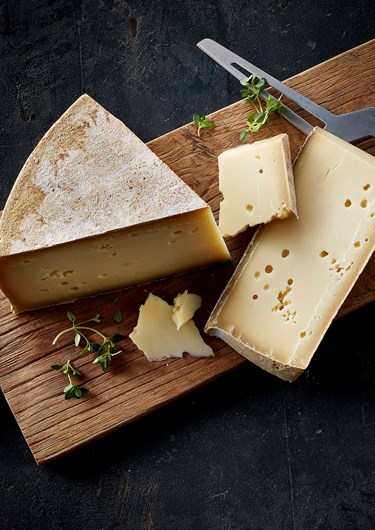Fontina cheese originates from the Aosta Valley in northern Italy. It is a cow’s milk cheese that has gained popularity worldwide, including in the United States, Denmark, Sweden, Canada, France, and Argentina.
Fontina is a semi-soft cheese when it is young, but it becomes hard as it matures. Its texture is creamy and smooth, and it has a nutty, earthy flavor that becomes more pungent as it ages. Fontina is a versatile cheese that can be used in a variety of dishes, such as pizza, pasta, quiches, and gratins.
We will explore the history, production, types, and uses of Fontina cheese.
The Birthplace Of Fontina Cheese
Fontina cheese, a delicious semi-soft cheese with a nutty and earthy flavor, has its origins in the picturesque Aosta Valley of northern Italy. Let’s explore the rich history and the geographical significance of this renowned cheese.
The Aosta Valley: A Cheese Haven
The Aosta Valley, located in the Italian Alps, is a region renowned for its centuries-old tradition of cheese-making. This breathtaking valley, surrounded by majestic mountains, provides an ideal environment for dairy farming, with lush pastures that contribute to the unique flavor of Fontina cheese.
The Aosta Valley is home to small, family-run dairies where the traditional methods of cheese production have been preserved for generations. The commitment to quality and authenticity is evident in every wheel of Fontina cheese that comes from this region.
Historical Origins Of Fontina
Fontina cheese has a rich history dating back to the 12th century, making it one of the oldest cheeses in Italy. The cheese-making traditions in the Aosta Valley have been passed down through the ages, and Fontina has become an integral part of the region’s cultural heritage.
The unique climate and geography of the Aosta Valley have played a significant role in shaping the character of Fontina cheese. The cool, mountainous environment and the use of raw cow’s milk contribute to its distinct flavor profile, setting it apart from other cheeses.

Credit: www.castellocheese.com
Traditional Production Methods
Fontina cheese originates from the Aosta Valley region in northern Italy, where traditional production methods are used. Made from cow’s milk, Fontina is a versatile cheese perfect for enhancing Italian dishes like pizza, pasta, and quiche.
Traditional Production Methods Unpasteurized Milk: A Key Ingredient Fontina cheese, a renowned Italian cheese, is traditionally produced using unpasteurized cow’s milk. This high-quality milk is a key ingredient in creating the distinct flavor and texture of Fontina cheese. The unpasteurized milk undergoes a meticulous process that contributes to the cheese’s exceptional taste and aroma. Artisanal Techniques and Aging The production of Fontina cheese involves artisanal techniques that have been passed down through generations. Skilled cheesemakers meticulously craft each wheel of Fontina using traditional methods, including hand-stirring the curds and carefully monitoring the aging process. The cheese is aged in special cellars, allowing it to develop its unique flavor profile and creamy texture. In the next stage, the cheese is aged for a minimum of three months, during which it develops a nutty and earthy flavor profile. As it ages, Fontina’s texture becomes increasingly smooth and supple, making it a versatile cheese that can be enjoyed in a variety of culinary applications.Fontina’s Global Journey
Fontina cheese, with its rich and creamy flavor, has made a remarkable journey from its origins in Italy to achieving international fame. Let’s explore how this beloved cheese has become a culinary sensation around the world.
From Italy To International Fame
Originating from the beautiful Valle d’Aosta region of northern Italy, Fontina cheese has a long-standing reputation for its exceptional quality. It is traditionally made from the milk of cows grazing on the lush alpine pastures of Aosta Valley. The unique combination of the region’s climate, soil, and grazing conditions contributes to the distinct flavors and characteristics of Fontina cheese.
As the popularity of Fontina grew, its production expanded beyond Italy’s borders. Today, you can find Fontina cheese being made in various countries, including the United States, Denmark, Sweden, Canada, France, and Argentina. However, the Italian Fontina still holds a special place in the hearts of cheese connoisseurs.
Local Variations Worldwide
While the Italian Fontina remains the original and most renowned version, different regions have put their own twist on this delectable cheese. Each local variation adds a unique touch to the flavor profile, making for an exciting culinary experience.
In the United States, Wisconsin has become a hub for Fontina production, offering its own interpretation of this Italian classic. Danish Fontina showcases the expertise of Danish cheesemakers, while Swedish Fontina adds a Scandinavian twist.
Canada, France, and Argentina have also embraced Fontina cheese, incorporating their local traditions and flavors into its production. Each of these variations has its own distinct qualities, influenced by the regional terroir and cheesemaking techniques.
With its global journey, Fontina cheese has captivated taste buds worldwide. Whether enjoyed in its traditional Italian form or one of the local variations, Fontina continues to be a beloved cheese that adds depth and richness to a wide range of dishes.
Culinary Uses Of Fontina Cheese
Hailing from the Aosta Valley in Italy, Fontina cheese is a versatile ingredient cherished in Italian cuisine. Its creamy texture and nutty flavor make it ideal for melting in pasta dishes, quiches, and gratins, adding a rich and savory taste to your culinary creations.
Fontina In Italian Cuisine
Fontina cheese, with its creamy texture and nutty flavor, is a staple ingredient in Italian cuisine. This versatile cheese adds richness and depth to a wide range of dishes, making it a favorite among chefs and home cooks alike. In traditional Italian cooking, Fontina is often used in pasta dishes, such as the classic Italian recipe, Pasta alla Carbonara. The cheese melts beautifully, creating a luscious sauce that coats the pasta perfectly. Its mild yet distinctive flavor enhances the overall taste of the dish, adding a savory element that pairs well with the richness of the eggs and pancetta. Another popular Italian dish that features Fontina cheese is the famous Pizza Quattro Formaggi. This four-cheese pizza is a heavenly combination of Fontina, mozzarella, Gorgonzola, and Parmesan. The Fontina cheese melts beautifully, creating a creamy and gooey texture that complements the other cheeses, resulting in a decadent and flavorful pizza.Versatility In International Dishes
Fontina cheese’s versatility extends beyond Italian cuisine. It also finds its way into various international dishes, adding its unique character and enhancing the overall taste. In French cuisine, Fontina is often used in gratins and tartiflette, a traditional Savoyard dish made with potatoes, bacon, onions, and Reblochon cheese. The creamy and melty Fontina cheese adds richness and depth to the dish, making it a comforting and satisfying meal. Fontina cheese also makes its appearance in Swiss cuisine, particularly in dishes like Fondue and Raclette. When melted, the cheese becomes smooth and creamy, perfect for dipping bread or drizzling over boiled potatoes and vegetables. Its mild yet distinct flavor adds a delightful touch to these cheesy Swiss classics. Furthermore, Fontina can be a great addition to sandwiches, omelets, and even burgers, bringing a burst of flavor and creaminess to these dishes. Its melting properties make it ideal for grilled sandwiches, where it becomes gooey and indulgent. Whether you’re exploring Italian cuisine or experimenting with international flavors, Fontina cheese is a versatile ingredient that adds a touch of richness and flavor to various dishes. Its creamy texture and nutty taste make it a favorite among chefs and food enthusiasts worldwide.Comparing Fontina To Other Cheeses
Fontina cheese originates from the Aosta Valley in northern Italy. It is a cow’s milk cheese with a semi-soft texture, ideal for melting in various dishes. Fontina can be compared to Gruyere, known for its creamy smoothness and versatility in cooking.
Comparing Fontina to Other Cheeses Fontina cheese is a semi-soft, washed-rind cheese that originated in the Aosta Valley region of northern Italy. It has a nutty, earthy flavor with a slightly sweet finish, and it’s commonly used in dishes like pizza, pasta, and quiches. While Fontina cheese is a unique and flavorful cheese, it’s always helpful to know what other cheeses it can be compared to and what substitutes can be used in recipes. Fontina vs. Gruyere: Textural Differences When comparing Fontina cheese to Gruyere cheese, it’s important to note that Gruyere is a hard cheese while Fontina is a semi-soft cheese. While both cheeses are delicious when melted, Fontina has a creamier texture and a milder flavor compared to the nutty and slightly sweet flavor of Gruyere. However, mature Fontina cheese can become hard and develop a sharper flavor that is more similar to Gruyere. Substitutes for Fontina in Recipes If you’re unable to find Fontina cheese at your local grocery store, there are several substitutes that you can use in your recipes. Washed-rind Alpine cheeses like Challerhocker or Taleggio can be used as a substitute for Fontina, as well as unwashed Alpine cheeses like Gruyere or Raclette. Gouda and Provolone are also great substitutes for Fontina cheese. When choosing a substitute, it’s important to consider the flavor and texture of the cheese to ensure that it complements the other ingredients in the recipe. In conclusion, while Fontina cheese is a unique and flavorful cheese, there are several other cheeses that it can be compared to and used as substitutes in recipes. Whether you choose to use Fontina or a substitute, your dish is sure to be delicious and full of flavor.
Credit: www.britannica.com

Credit: en.wikipedia.org
Frequently Asked Questions
What Cheese Is Closest To Fontina?
For a Fontina substitute, try washed-rind Alpine cheeses like Taleggio, Challerhocker, or unwashed options like Gruyere, raclette, Gouda, or Provolone.
What Is Fontina Cheese Good For?
Fontina cheese is a versatile ingredient in Italian cuisine, perfect for use in pizza, pasta, quiche, and gratins. It pairs well with warm chicken sandwiches and can be substituted with other washed-rind or unwashed Alpine cheeses like Challerhocker, Taleggio, Gruyere, raclette, Gouda, or Provolone.
Fontina is a semi-soft cow’s milk cheese that originated in Italy’s Aosta Valley region and has since been produced worldwide. When melted, it becomes luxuriously smooth and creamy with just the right amount of stretch.
What’s The Difference Between Fontina And Gruyere Cheese?
Fontina and Gruyere cheese differ in terms of firmness. Gruyere is a hard cheese, while fontina’s firmness varies based on maturity. Both cheeses melt smoothly and have a creamy texture. Substitute options for fontina include Challerhocker, Taleggio, Gouda, Provolone, and raclette.
Fontina is commonly used in Italian dishes like pizza, pasta, quiche, and gratins. It pairs well with warm chicken sandwiches. Fontina cheese is made from cow’s milk and originated in Italy’s Aosta Valley region.
What Animal Does Fontina Cheese Come From?
Fontina cheese comes from cows. It is a cow’s milk cheese that was first produced in Italy. It has since been produced worldwide, including in the United States, Denmark, Sweden, Canada, France, and Argentina.
Where Is Fontina Cheese Originally From?
Fontina cheese is originally from the Aosta Valley in the Alps of northern Italy.
Conclusion
Fontina cheese is a delicious and versatile cheese that originated in the Aosta Valley region of Italy. It is a cow’s milk cheese that can be enjoyed in a variety of Italian dishes such as pizza, pasta, quiche, and gratins.
Fontina cheese pairs well with warm chicken sandwiches and adds a creamy and smooth texture when melted. It is similar to Gruyere cheese, but the firmness of Fontina cheese depends on its maturity. Overall, Fontina cheese is a must-try for cheese lovers looking to add a touch of Italian flavor to their meals.














